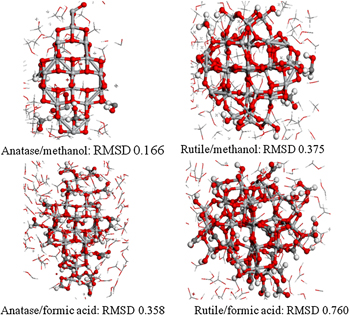Crossref Citations
This article has been cited by the following publications. This list is generated based on data provided by
Crossref.
Huang, Liangliang
Gubbins, Keith E.
Li, Licheng
and
Lu, Xiaohua
2014.
Water on Titanium Dioxide Surface: A Revisiting by Reactive Molecular Dynamics Simulations.
Langmuir,
Vol. 30,
Issue. 49,
p.
14832.
Wen, D. S.
and
Song, P. X.
2014.
Metal Nanopowders.
p.
25.
Nouranian, S.
Tschopp, M. A.
Gwaltney, S. R.
Baskes, M. I.
and
Horstemeyer, M. F.
2014.
An interatomic potential for saturated hydrocarbons based on the modified embedded-atom method.
Phys. Chem. Chem. Phys.,
Vol. 16,
Issue. 13,
p.
6233.
Huygh, Stijn
Bogaerts, Annemie
van Duin, Adri C.T.
and
Neyts, Erik C.
2014.
Development of a ReaxFF reactive force field for intrinsic point defects in titanium dioxide.
Computational Materials Science,
Vol. 95,
Issue. ,
p.
579.
Bhattacharyya, Kaustava
Wu, Weiqiang
Weitz, Eric
Vijayan, Baiju
and
Gray, Kimberly
2015.
Probing Water and CO2 Interactions at the Surface of Collapsed Titania Nanotubes Using IR Spectroscopy.
Molecules,
Vol. 20,
Issue. 9,
p.
15469.
Curnan, Matthew T.
and
Kitchin, John R.
2015.
Investigating the Energetic Ordering of Stable and Metastable TiO2 Polymorphs Using DFT+U and Hybrid Functionals.
The Journal of Physical Chemistry C,
Vol. 119,
Issue. 36,
p.
21060.
Lu, Linghong
Quan, Xuebo
Dong, Yihui
Yu, Gaobo
Xie, Wenlong
Zhou, Jian
Li, Licheng
Lu, Xiaohua
and
Zhu, Yudan
2015.
Mesoscale Modeling in Chemical Engineering Part II.
Vol. 47,
Issue. ,
p.
85.
Monti, Susanna
Li, Cui
Ågren, Hans
and
Carravetta, Vincenzo
2015.
Dropping a Droplet of Cysteine Molecules on a Rutile (110) Interface: Reactive versus Nonreactive Classical Molecular Dynamics Simulations.
The Journal of Physical Chemistry C,
Vol. 119,
Issue. 12,
p.
6703.
Muñiz, Jesús
Rincón, Marina E.
and
Acevedo-Peña, Próspero
2016.
The role of the oxide shell on the stability and energy storage properties of MWCNT@TiO $$_2$$ 2 nanohybrid materials used in Li-ion batteries.
Theoretical Chemistry Accounts,
Vol. 135,
Issue. 7,
Mejía-Mendoza, L.M.
Valdez-Gonzalez, M.
Muñiz, Jesús
Santiago, U.
Cuentas-Gallegos, A.K.
and
Robles, M.
2017.
A theoretical approach to the nanoporous phase diagram of carbon.
Carbon,
Vol. 120,
Issue. ,
p.
233.
Yeon, Jejoon
He, Xin
Martini, Ashlie
and
Kim, Seong H.
2017.
Mechanochemistry at Solid Surfaces: Polymerization of Adsorbed Molecules by Mechanical Shear at Tribological Interfaces.
ACS Applied Materials & Interfaces,
Vol. 9,
Issue. 3,
p.
3142.
Hou, Dongshuai
Hu, Chuanlin
and
Li, Zongjin
2017.
Molecular Simulation of the Ions Ultraconfined in the Nanometer-Channel of Calcium Silicate Hydrate: Hydration Mechanism, Dynamic Properties, and Influence on the Cohesive Strength.
Inorganic Chemistry,
Vol. 56,
Issue. 4,
p.
1881.
Tschopp, Mark A.
Chris Rinderspacher, B.
Nouranian, Sasan
Baskes, Mike I.
Gwaltney, Steven R.
and
Horstemeyer, Mark F.
2018.
Quantifying Parameter Sensitivity and Uncertainty for Interatomic Potential Design: Application to Saturated Hydrocarbons.
ASCE-ASME Journal of Risk and Uncertainty in Engineering Systems, Part B: Mechanical Engineering,
Vol. 4,
Issue. 1,
Malali, Sanaz
and
Foroutan, Masumeh
2018.
Dissociation behavior of water molecules on defect-free and defective rutile TiO2 (1 0 1) surfaces.
Applied Surface Science,
Vol. 457,
Issue. ,
p.
295.
Fazio, Gianluca
Selli, Daniele
Ferraro, Lorenzo
Seifert, Gotthard
and
Di Valentin, Cristiana
2018.
Curved TiO2 Nanoparticles in Water: Short (Chemical) and Long (Physical) Range Interfacial Effects.
ACS Applied Materials & Interfaces,
Vol. 10,
Issue. 35,
p.
29943.
Biriukov, Denys
Kroutil, Ondřej
and
Předota, Milan
2018.
Modeling of solid–liquid interfaces using scaled charges: rutile (110) surfaces.
Physical Chemistry Chemical Physics,
Vol. 20,
Issue. 37,
p.
23954.
Daub, Christopher D.
Cann, Natalie M.
Bratko, D.
and
Luzar, Alenka
2018.
Electrokinetic flow of an aqueous electrolyte in amorphous silica nanotubes.
Physical Chemistry Chemical Physics,
Vol. 20,
Issue. 44,
p.
27838.
Shin, Yun Kyung
Sengul, Mert Y.
Jonayat, A. S. M.
Lee, Wonho
Gomez, Enrique D.
Randall, Clive A.
and
Duin, Adri C. T. van
2018.
Development of a ReaxFF reactive force field for lithium ion conducting solid electrolyte Li1+xAlxTi2−x(PO4)3 (LATP).
Physical Chemistry Chemical Physics,
Vol. 20,
Issue. 34,
p.
22134.
Muñiz, Jesús
Espinosa-Torres, Néstor David
Guillén-López, Alfredo
Longoria, Adriana
Cuentas-Gallegos, Ana Karina
and
Robles, Miguel
2019.
Insights into the design of carbon electrodes coming from lignocellulosic components pyrolysis with potential application in energy storage devices: A combined in silico and experimental study.
Journal of Analytical and Applied Pyrolysis,
Vol. 139,
Issue. ,
p.
131.
Ta, T.D.
Tieu, A.K.
Zhu, H.
Wan, S.
Phan, H.T.
and
Hao, J.
2019.
Influence of molecular structure on lubrication of aqueous triblock copolymer lubricants between rutile surfaces: An MD approach.
Tribology International,
Vol. 130,
Issue. ,
p.
170.





